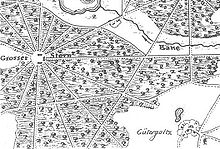
Friedenau is a locality (Ortsteil) within the borough (Bezirk) of Tempelhof-Schöneberg in Berlin, Germany. Relatively small by area, its population density is the highest in the city.

Steinstücken, with approximately 300 residents, is a small outlying neighborhood of the Wannsee district in the Berlin borough of Steglitz-Zehlendorf. From the division of Germany in 1949 until a connecting corridor was created in 1971–72, Steinstücken was the only permanently inhabited of twelve original exclaves of West Berlin in East Germany, while West Berlin itself was an enclave controlled by the Western Allies, surrounded by East German (GDR) territory.

Teltow [German pronunciation:['tɛltoː] ] is a town in the Potsdam-Mittelmark district, in Brandenburg, Germany.

Kleinmachnow is a municipality of about 20,000 inhabitants in the Potsdam-Mittelmark district, in Brandenburg, Germany. It is situated south-west of the borough of Steglitz-Zehlendorf and east of Potsdam.
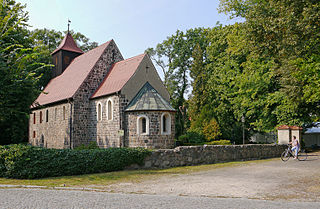
Stahnsdorf is a municipality in the Potsdam-Mittelmark district, in Brandenburg, Germany.
High Fläming Nature Park is an 827 km2 nature park in Potsdam-Mittelmark district in the German state Brandenburg. It is the third largest of 11 nature parks in the state of Brandenburg. In 1997, it was declared a nature park by the State Minister for the Environment.

The Margraviate of Brandenburg was a major principality of the Holy Roman Empire from 1157 to 1806 that played a pivotal role in the history of Germany and Central Europe.

Palaces and Parks of Potsdam and Berlin are a group of palace complexes and extended landscaped gardens located in the Havelland region around Potsdam and the German capital of Berlin. The term was used upon the designation of the cultural ensemble as a World Heritage Site by UNESCO in 1990. It was recognized for the historic unity of its landscape—a unique example of landscape design against the background of monarchic ideas of the Prussian state and common efforts of emancipation.
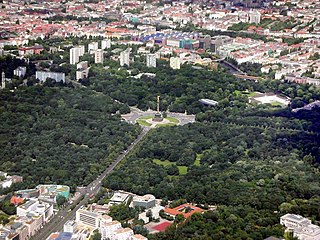
The Tiergarten, formal German name: Großer Tiergarten, is Berlin's most popular inner-city park, located completely in the district of the same name. The park is 210 hectares in size and is among the largest urban gardens of Germany. Only the Tempelhofer Park and Munich's Englischer Garten are larger.
The Expressway Potsdam-Schönefeld is the overarching term for a number of transport projects to create a single four-lane, primarily grade-separated highway from Potsdam to Schönefeld south of Berlin, Germany.
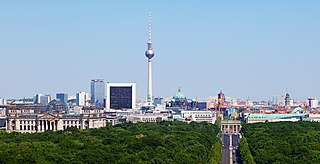
The Berlin/Brandenburg metropolitan region or capital region is one of eleven metropolitan regions of Germany, consisting of the entire territories of the state of Berlin and the surrounding state of Brandenburg. The region covers an area of 30,545 square kilometres (11,793 sq mi) with a total population of about 6.2 million.

Teltow station is located in the town of Teltow on the Anhalt Railway south of Berlin and was opened in 1901. Since then, the station has been repeatedly remodelled. The station served regional passenger and freight traffic and was the terminus of a Berlin S-Bahn service from 1950 to 1961. The direct connection to Berlin was lost with the construction of the Berlin Wall in 1961. It was restored in 2006.

Geographically, the Havelland is the region around which the River Havel flows in a U-shape between Oranienburg to the northeast and Rhinow to the northwest. The northern boundary of the Havelland is formed by the River Rhin and the Rhin Canal. In the history of Brandenburg, the Havelland represents a historic region.

Teltow is both a geological plateau and also a historical region in the German states of Brandenburg and Berlin. As an historical region, the Teltow was one of the eight territories out of which the March of Brandenburg was formed in the 12th and 13th centuries. As a result of the Teltow War (1239–1245) the question of territorial lordship of the newly created heart of the expanding march was finally decided here. Between 1835 and 1952 there was also a county, Teltow district; in addition a town immediately south of Berlin, in the present-day county of Potsdam-Mittelmark, bears the name Teltow.

The Par force hunting landscape in North Zealand is a collection of hunting grounds and forests north of Copenhagen. The landscape was submitted for admission to the UNESCO List of World Heritage Sites on 1 August 2010 and was inscribed on 4 July 2015. The landscape comprises three main areas: Store Dyrehave, Gribskov and Jægersborg Dyrehave/Jægersborg Hegn, and contains the most significant hunting grounds for the medieval nobility in Denmark. The central-star grid design of the landscape, with numbered roads and stone posts, fences, demonstrates the unique planning and design of hunting landscapes in the 17th and 18th centuries.

Store Dyrehave is a forest located to the east of the village Ny Hammersholt immediately south of Hillerød, on both sides of Københavnsvej, in North Zealand, Denmark. Consisting of conifers and beech, it was enclosed with stone walls in 1619–28 as a royal deer park for hunting. In 1680, Christian V introduced a geometrical system of roads forming a star with eight branches for par force hunting. Although par force hunting was discontinued in 1777, the road system and numbered stone posts remain fully intact. Store Dyrehave is one of the three forests forming the Par force hunting landscape in North Zealand, a UNESCO World Heritage Site.

The Central Brandenburg Plateaux and Lowlands form a natural region in the German state of Brandenburg and in parts of southwest Berlin and the east of Saxony-Anhalt. They are major unit group 81 in the system of natural regions of Germany and part of the East German Plateaux and Heathlands. The Brandenburg portion of the Central Brandenburg Plateaux and Lowlands is largely coincident with the natural region designated as the Central March in the structural atlas of the state of Brandenburg.
Spirit Creek Forest is a state forest in Richmond County, Georgia. The forest is 725 acres and is managed by the Georgia Forestry Commission. The forest is mostly made up of wetlands, loblolly pines, and bottomland hardwoods.

The Stahnsdorf South-Western Cemetery is a Protestant rural cemetery in Germany. Established in 1909, the cemetery is located in the municipality of Stahnsdorf in Potsdam-Mittelmark district, Berlin/Brandenburg Metropolitan Region. With a land area of approximately 206 ha, it is the largest church-owned Christian cemetery in Germany, as well as being the tenth largest cemetery in the world and Germany's second largest cemetery after Hamburg's Ohlsdorf Cemetery. The cemetery is operated by the administration of the Berlin City Protestant Synod Association. Due to its status as one of the most important landscape parks in the Berlin metropolitan area, along with the large amount of historically valuable tombs and other buildings which include the landmark wooden chapel, the cemetery was designated as a place of special importance and a protected area by the state of Brandenburg in 1982.
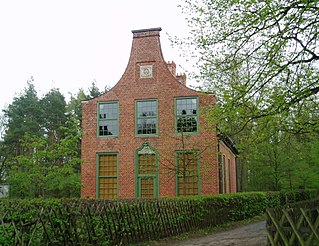
The Stern Hunting Lodge in Potsdam was built between 1730 and 1732 under the reign of the Soldier King Frederick William I in the style of a simple Dutch town house. The contract for the construction was probably awarded to Cornelius van den Bosch, a grenadier and master carpenter from Holland, and the building was supervised by Pierre de Gayette, Captain of the Corps of Engineers and Court Architect.




